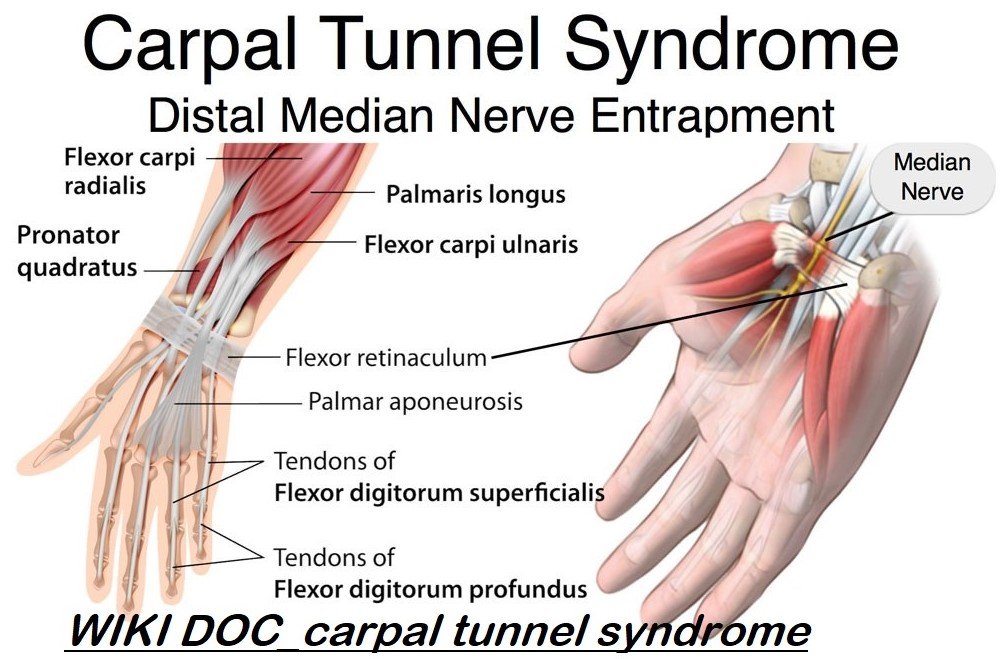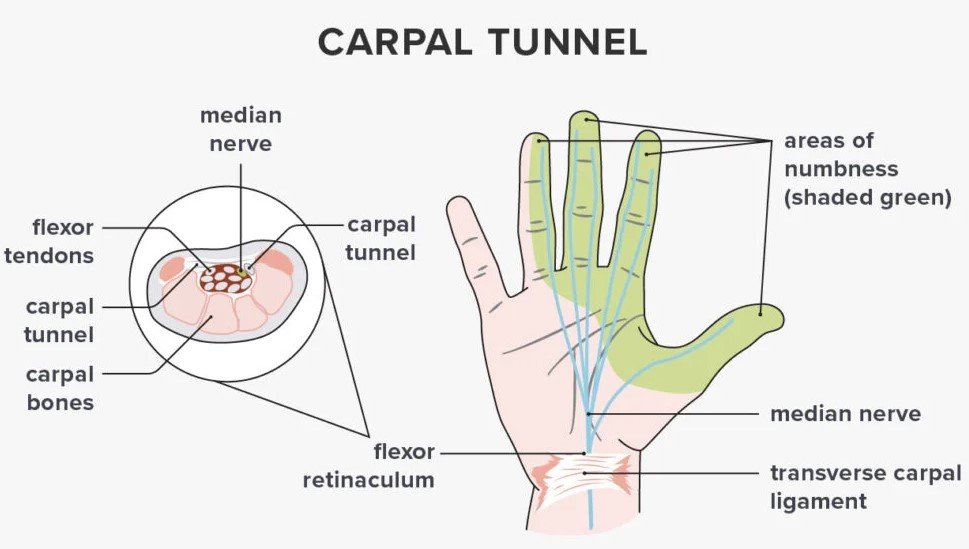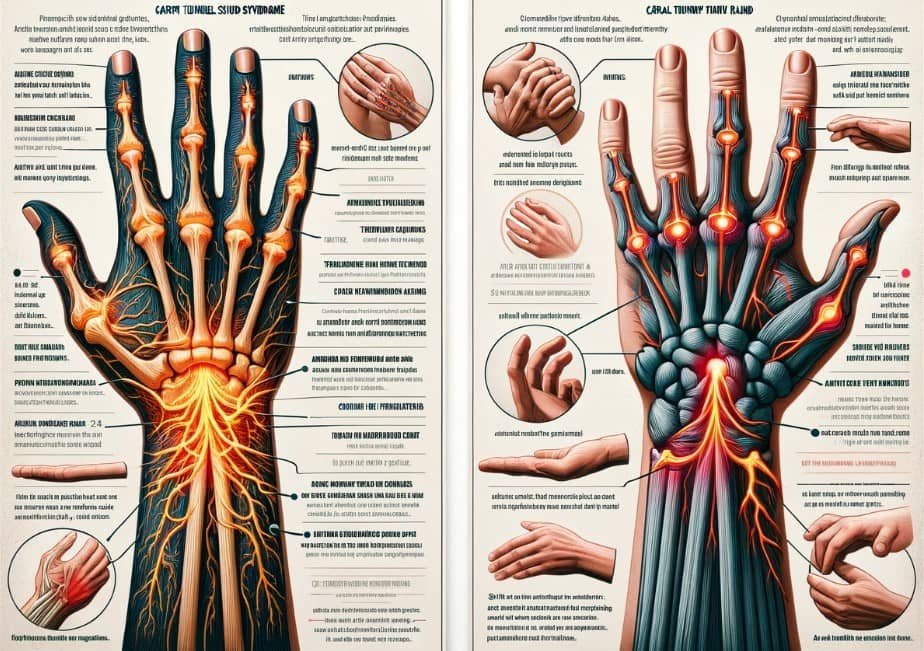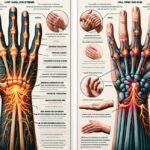Carpal tunnel syndrome (CTS) is a condition that frequently comes to mind when individuals experience persistent hand pain, often attributed to repetitive motions or certain risk factors. However, this diagnosis might not always be accurate. This article explores the intricacies of hand discomfort, shedding light on two conditions—arthritis and flexor tendonitis—that are commonly confused with CTS, and emphasizes the importance of accurate diagnosis and appropriate treatment for hand arthritis, tendonitis, and CTS alike.

Table of Contents
Identifying the Common Confusion: Tendonitis and Arthritis vs. Carpal Tunnel Syndrome
Many patients arrive at clinics, certain they’re battling carpal tunnel syndrome, prompted by their primary symptom of hand pain. Yet, it’s crucial to understand that arthritis and tendonitis are frequently mistaken for CTS. These conditions affect different parts of the hand and wrist and can closely mimic CTS symptoms.
Two conditions that are often misdiagnosed as carpal tunnel syndrome

It’s crucial to recognize arthritis and tendonitis, two conditions that are often misdiagnosed as carpal tunnel syndrome. Identifying the true source of pain through careful examination and patient history is the first step toward accurate diagnosis and effective treatment.
Through comprehensive examinations and detailed patient histories, healthcare professionals can accurately distinguish between these conditions. Carpal tunnel syndrome, known for its unique symptoms, necessitates a specific diagnostic strategy.
The Differences in Carpal Tunnel, Arthritis, and Tendonitis – Dr. David R. Miller
Symptom Overlap: How Arthritis and Flexor Tendonitis Resemble CTS
The trio of conditions—carpal tunnel syndrome, arthritis, and tendonitis—often manifest as hand pain, leading many to seek clarification online, where CTS emerges as a common culprit due to its widespread recognition as a nerve compression issue.
Differentiating these conditions requires an extensive approach, incorporating thorough physical assessments and detailed patient histories. CTS is characterized by nocturnal discomfort, numbness in the thumb, index, and ring fingers, and potential muscle weakness. Tendonitis symptoms vary based on the affected tendon, leading to pain and stiffness, while arthritis in the fingers typically causes morning stiffness, a symptom mistakenly linked to nerve issues.
What is commonly misdiagnosed as Pink eye – Conjunctivitis?
Carpal Tunnel Syndrome Versus Arthritis in the Hand and Wrist
When evaluating for CTS, healthcare practitioners look for specific symptoms in patients’ histories, including night-time discomfort. In contrast, hand and wrist arthritis manifests differently, with patients reporting pain associated with hand usage, especially around the thumb base—a common site for arthritis discomfort. They describe challenges with gripping and pinching, unlike the nocturnal pain linked to CTS. Notably, the numbness and tingling characteristic of nerve compression in CTS are not common in arthritis-related pain.
Distinguishing Flexor Tendonitis from Carpal Tunnel Syndrome
Tendonitis, including conditions like trigger finger, exhibits distinct symptoms such as finger stiffness and difficulty moving when flexed. Those with tendonitis often report localized pain and tenderness around the hand’s flexor tendons, exacerbated by hand movement.
Conversely, while CTS also includes hand pain during activity, it is marked by specific signs such as nocturnal discomfort, numbness, and tingling in the fingers—indicative of nerve compression. Weakness and holding difficulties are more commonly associated with nerve entrapment, creating a clear distinctio.
Treatment: CTS, Tendonitis, and Arthritis
Treatment approaches for CTS often begin conservatively, with nighttime splinting being an effective initial step. Should symptoms persist or worsen, advanced options like cortisone injections or carpal tunnel release surgery might be considered. This surgery, typically short and performed under local anesthesia, directly addresses the median nerve compression, offering significant symptom relief.
For tendonitis, initial treatments may include splinting and injections. In particular cases, such as trigger finger, a surgical release may be necessary to resolve mechanical issues, offering immediate improvement.
If you’re navigating hand pain or similar symptoms, it’s vital to pursue a precise diagnosis and tailored treatment plan. Contacting a specialized clinic like Town Center Orthopaedics can be your first step toward understanding your condition and embarking on a path to relief.
Frequently Asked Questions
- What are the primary symptoms of carpal tunnel syndrome? Carpal tunnel syndrome is characterized by nocturnal pain, numbness, and tingling in the thumb, index, and middle fingers, often leading to weakness in the hand.
- How can I tell if my hand pain is due to arthritis or carpal tunnel syndrome? Arthritis-related hand pain typically worsens with use, especially in activities involving gripping and pinching, whereas carpal tunnel syndrome often causes nocturnal pain and numbness.
- What treatment options are available for carpal tunnel syndrome? Treatment can range from conservative approaches like nighttime splinting to surgical options such as carpal tunnel release for more severe cases.
- Can tendonitis be mistaken for carpal tunnel syndrome? Yes, tendonitis can mimic carpal tunnel syndrome due to overlapping symptoms like hand pain, but it lacks the nocturnal pain and specific numbness pattern of CTS.
- Is surgery always necessary for treating carpal tunnel syndrome? No, surgery is typically considered only after conservative treatment options have been exhausted and if the patient continues to experience significant symptoms.
For more insightful tips and comprehensive guides on enhancing your wellness journey, don’t forget to explore our main page at WellnessTips24.com





